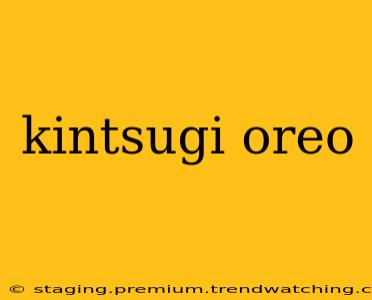The internet is abuzz with the captivating image of "Kintsugi Oreos"—the iconic chocolate sandwich cookie repaired with the elegant Japanese art of Kintsugi. While not an officially released product from Oreo, the concept has ignited imaginations and sparked conversations about embracing imperfection, celebrating repair, and finding beauty in brokenness. This post delves into the fascinating world of Kintsugi Oreos, exploring the art form, the viral trend, and the deeper meaning behind this unique culinary concept.
What is Kintsugi?
Kintsugi, meaning "golden joinery" in Japanese, is an ancient art form that involves repairing broken pottery with lacquer dusted with powdered gold, silver, or platinum. Instead of hiding the cracks, Kintsugi celebrates them, transforming the broken object into something more beautiful and unique than before. The philosophy behind Kintsugi emphasizes the beauty of imperfection and the acceptance of life's inevitable flaws. This philosophy aligns perfectly with the idea of repairing broken Oreos.
How are Kintsugi Oreos Made?
There's no single, official method for creating Kintsugi Oreos. The beauty lies in the creativity and individual expression of the maker. However, the general process typically involves:
- Breaking an Oreo: Carefully break an Oreo into two or more pieces. The more dramatic the break, the more pronounced the Kintsugi effect will be.
- Preparing the Adhesive: Food-safe glue or melted chocolate can be used to carefully reattach the broken pieces.
- Applying the "Gold": Once the glue or chocolate is set, edible gold leaf, gold paint, or even finely crushed gold sprinkles can be used to highlight the cracks and seams, mimicking the traditional Kintsugi technique. Creativity is key here! Some use colored sanding sugar for a different aesthetic.
- Setting and Enjoying: Allow the adhesive to fully set before carefully handling or eating your Kintsugi Oreo.
What Makes Kintsugi Oreos So Popular?
The appeal of Kintsugi Oreos transcends the simple act of repairing a broken cookie. It speaks to a deeper cultural shift towards embracing imperfections and finding beauty in things that are not perfect. The trend taps into several powerful themes:
- Mindfulness and Creativity: The process is therapeutic and encourages mindful creativity.
- Sustainability: Repairing something instead of discarding it aligns with the growing movement towards reducing waste.
- Aesthetic Appeal: The contrast of the dark cookie and the shimmering gold creates a visually striking image that is highly shareable on social media.
Are Kintsugi Oreos Edible?
Yes, as long as food-safe materials are used in the repair process. Edible gold leaf or gold paint specifically designed for food use are essential for safety. Always ensure that any adhesive used is non-toxic and safe for consumption.
What other foods can be "Kintsugied"?
The Kintsugi aesthetic is not limited to Oreos. Many people are applying this technique to other treats and even everyday objects. Think about repairing broken pottery, a cracked phone case (with non-edible materials), or even a chipped mug. The possibilities are truly endless.
Can I sell Kintsugi Oreos?
Creating and selling Kintsugi Oreos would require careful consideration of food safety regulations and intellectual property rights. If you are interested in selling these uniquely designed cookies, it's crucial to thoroughly research and comply with all applicable laws and regulations.
Conclusion: Embracing the Imperfect Beauty of Kintsugi Oreos
Kintsugi Oreos represent more than just a quirky food trend. They symbolize a deeper appreciation for imperfection and the beauty of repair. They are a testament to human creativity and our ability to find joy in unexpected places. Whether you attempt to create your own or simply admire the artistry, the concept of Kintsugi Oreos offers a delicious and insightful reflection on the beauty of imperfection.

